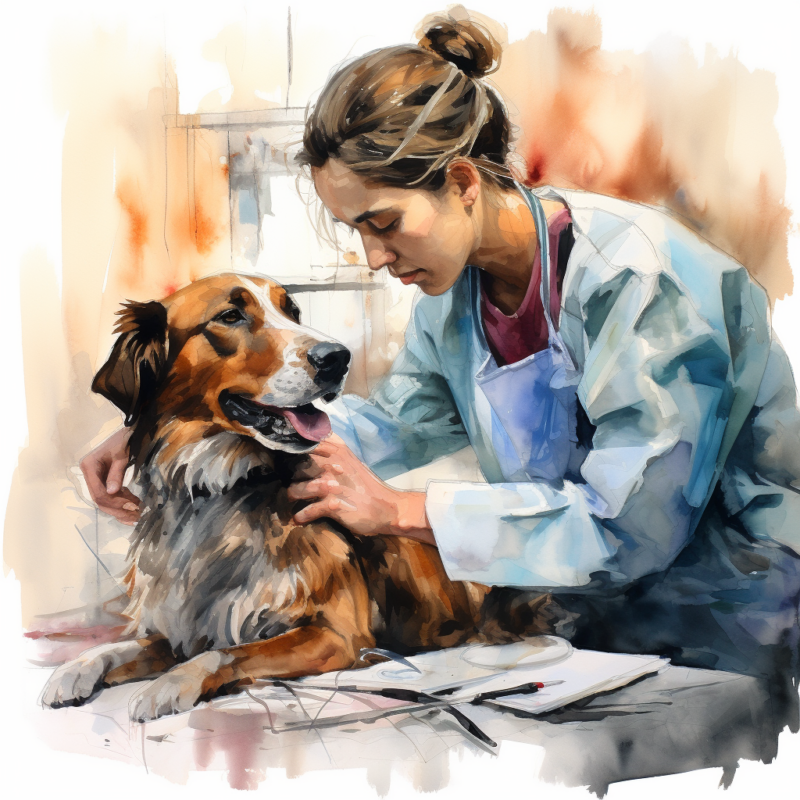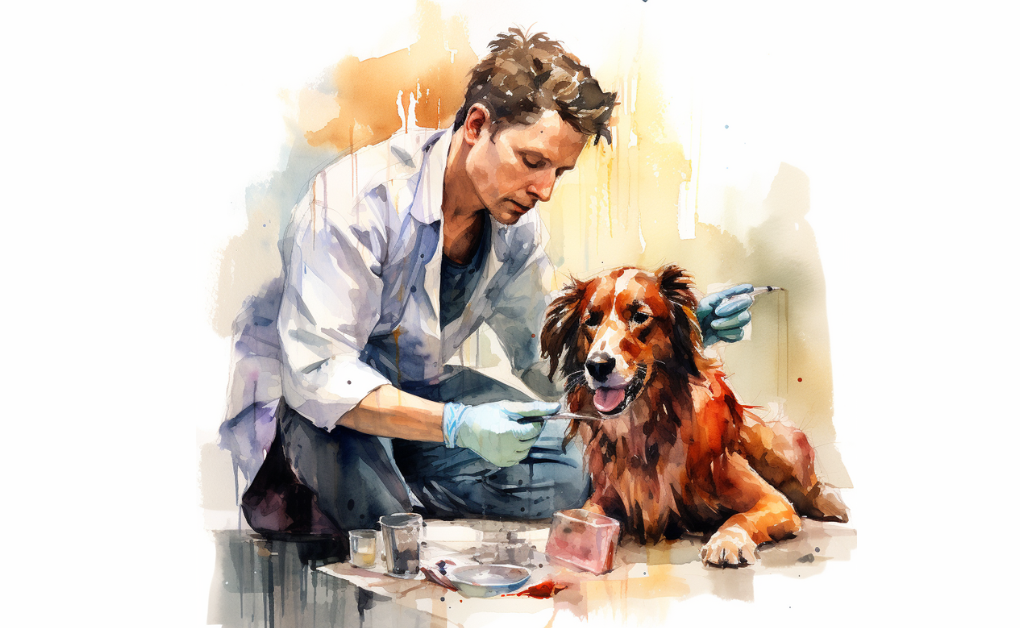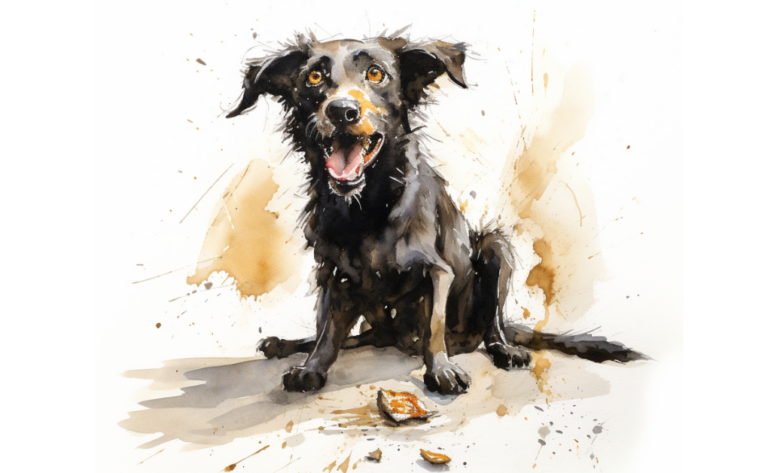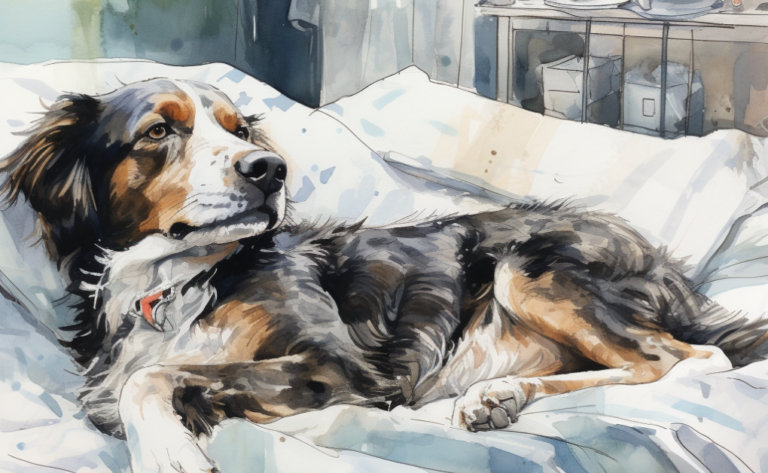What is Soft Tissue Trauma in Dogs?
What is it?
How is it Treated?
Breed Predispositions
Any dog, regardless of breed or age, can be affected by this condition. However, factors such as activity level, lifestyle, and environment may increase the risk of soft tissue trauma in some dogs.
Introduction
While playing fetch with her beloved Australian Shepherd, Milo, in their backyard, Nicole noticed him suddenly yelping in pain and limping after an awkward landing. Concerned about her furry companion’s well-being, she carefully examined him and realized that he might have sustained an injury to his muscles or tendons. After taking Milo to the veterinarian, he was diagnosed with soft tissue trauma, a common type of injury in active dogs.
Soft tissue trauma in dogs pertains to damages that impact the non-osseous components of a dog’s body, such as muscles, tendons, ligaments, skin, fat, blood vessels, and nerves. These common injuries, manifest as scar tissue, compression, or other types of damage, can range from mild to severe injuries. They may stem from various external factors, potentially affecting any breed, though working dogs, large breed dogs, and even smaller dogs are often susceptible. A dog’s overall mobility, comfort, and quality of life can be significantly impacted by soft tissue trauma, emphasizing the importance of appropriate monitoring and management of these injuries.

Common Types of Soft Tissue Trauma in Dogs
1. Bruises and Contusions
Bruises and contusions in dogs occur when there is damage to the blood vessels beneath the skin, causing blood to leak into the surrounding tissues. This results in the characteristic discoloration and swelling associated with bruises. These injuries can be caused by various factors, such as blunt force trauma, falls, or rough play.
Bruises and contusions can be painful for the dog and may limit their mobility temporarily. While they often heal independently, monitoring the affected area for any signs of worsening or complications is essential. In severe cases, consultation with a veterinarian is recommended for appropriate pain management and treatment.
2. Sprains
Sprains in dogs occur when the ligaments that connect bones are stretched or torn, usually due to sudden twisting or impact. These injuries commonly affect the dog’s legs, particularly the knee and ankle joints. Sprains can cause pain, swelling, and limited mobility, making it difficult for the dog to put weight on the affected limb.
3. Strains
Strains in dogs occur when a muscle or tendon is stretched, pulled, or torn, usually due to overexertion or sudden movements. These injuries commonly affect a dog’s legs, particularly the muscles supporting the hip, thigh, and shoulder. Strains can cause pain, swelling, and stiffness, limiting mobility and difficulty putting weight on the affected limb. Mild strains may resolve with rest and limited activity, but more severe cases may require veterinary intervention.
4. Lacerations
Lacerations in dogs are cuts or tears in the skin that can range from superficial to deep, potentially affecting underlying tissues and structures. They can occur due to accidents, bites, or contact with sharp objects. Lacerations can vary in severity and appearance, from clean, straight cuts to jagged, irregular tears. Depending on the depth and location of the wound, lacerations can cause pain, bleeding, and potential risk of infection. Immediate care for a laceration includes cleaning the wound with mild soap and water, applying pressure to stop any bleeding, and covering the area with a clean bandage.
5. Abrasions
Abrasions in dogs are superficial injuries that involve the scraping or wearing away of the top layer of the skin, known as the epidermis. These injuries can result from friction or rubbing against rough surfaces, such as concrete or carpets, or minor accidents during play or exercise. Abrasions can cause pain, redness, and mild bleeding, but they are generally less severe than other skin injuries like lacerations or punctures.
6. Puncture Wounds
Puncture wounds in dogs occur when a sharp, pointed object penetrates the skin and underlying tissues. These wounds can result from various causes, such as bites from other animals, stepping on sharp objects like nails or glass, or accidents involving sharp tools or equipment.
Puncture wounds may appear small on the surface, but they can be deep and cause significant damage to the underlying tissues, muscles, and organs. They also carry a higher risk of infection since bacteria can be introduced deep into the tissues.

7. Hematomas
In dogs, hematomas are localized blood collections outside the blood vessels, typically resulting from trauma or injury. They form when blood vessels are damaged, and blood leaks into the surrounding tissues, creating a swollen, painful area. Hematomas are commonly found in the ears (aural hematoma) but can also develop in other body areas, such as the skin or internal organs.
Aural hematomas, which affect the ear flap, often occur when a dog vigorously shakes its head or scratches its ears, causing blood vessels within the ear flap to rupture. The trapped blood leads to a swollen, painful ear flap that may feel warm.
8. Crush Injuries
Crush injuries in dogs occur when a part of the dog’s body, such as a limb or the torso, is subjected to significant compressive force or pressure. For example, these injuries can result from accidents involving heavy objects falling on the dog, being hit by a car, or getting caught in a tight space. Crush injuries can be severe and life-threatening, as they often involve damage to multiple layers of tissue, including skin, muscles, blood vessels, nerves, and even bones. The extent of a crush injury can vary greatly, depending on the force involved and the duration of the compression.
9. Tendon and Ligament Injuries
Tendon and ligament injuries in dogs involve damage to the fibrous connective tissues that connect muscles to bones (tendons) and bones to other bones (ligaments). These injuries can occur due to various factors, such as sudden trauma, overuse, or degeneration over time. Common causes of tendon and ligament injuries include jumping, twisting, sudden direction changes during play or exercise, slipping on slippery surfaces, or repetitive strain from daily activities.
10. Internal Injuries
Internal injuries in dogs refer to damage to the body’s organs, blood vessels, or other structures. These injuries can occur due to various causes, such as blunt force trauma (e.g., being hit by a car, falling from a height), penetrating injuries (e.g., bites, sharp objects), or even certain medical conditions and diseases.
Causes of Soft Tissue Trauma in Dogs
Soft tissue trauma in dogs, a common issue, can be precipitated by multiple factors, including:
- Accidental incidents: Dog injuries, particularly common in dogs, often stem from car collisions, tumbles from significant heights, or run-ins with stationary objects or other animals. These accidents can lead to various soft tissue damage, from moderate sprains to more serious internal injuries.
- Bites and confrontations: In the aftermath of a dog fight, bite wounds can inflict significant soft tissue harm. Fights with other animals can cause punctures and lacerations, severe damage to tendons and ligaments, and even internal trauma.
- Excessive effort or repetitive stress: High-intensity activities or repetitive movements can result in overuse injuries, such as muscle strains or ligament sprains, which are types of soft tissue trauma.
- Contact with sharp objects: Dogs often encounter sharp items like glass shards, nails, or thorns, leading to skin lacerations, puncture wounds, or surface abrasions – all forms of soft tissue damage.
- Blunt trauma: A head injury or other damage caused by the impact of a blunt object, such as a bat or stick, can result in contusions, bruises, or more serious internal injuries.
- Compression injuries: When a dog becomes trapped under a substantial weight, like a toppling tree or vehicle, the resulting crush injuries can harm soft tissues and internal organs.
- Wildlife encounters: Encounters with wild animals, from snakes to large predators, can lead to puncture wounds, lacerations, or severe soft tissue trauma.
- Burns: Contact with hot surfaces, corrosive chemicals, or fire can cause burns, which are a form of soft tissue injury affecting both the skin and underlying tissues.
- Insect bites or stings: These can lead to localized swelling, redness, and discomfort in the affected area, constituting a mild soft tissue injury.
- Medical procedures: Sometimes, iatrogenic causes, such as injections or surgical interventions, can also lead to soft tissue trauma in dogs.
Given the potential severity of some of these injuries, taking your dog to the vet is crucial if you suspect any form of soft tissue trauma, from sprains and strains to more severe injuries like a stress fracture or eye injury.
Symptoms of Soft Tissue Trauma in Dogs
Symptoms of soft tissue trauma in dogs can range broadly based on the nature and gravity of the injury. Some of the most common indicators of these dog injuries include:
- A noticeable swelling or inflammation in the area of the acute injury
- A change in skin color, typically exhibiting redness or discoloration
- Evidence of bruising or contusions
- Pain or sensitivity to touch, often exacerbated during movement
- An irregular gait, such as limping or favoring a specific limb, indicative of lameness
- Stiffness or difficulty in maneuvering a joint (a potential sign of instability)
- A perceptible muscle weakness or functional loss in the area affected by the trauma
- Bleeding or discharge seeping from a wound
- An unusual sense of heat or warmth at the site of the injury
- A reluctance to move, engage in play, or participate in daily activities
- Signs of shock in severe cases, which might include pale gums, accelerated breathing, or a weak pulse
- Visible deformity or irregularity in the shape of the affected body part, such as the paw or cranial region
- Difficulty in breathing, a possible sign of internal injuries
Many of the same symptoms, such as pain and limited mobility, can also point to injuries to muscle, one of the most common forms of soft tissue trauma in dogs. Suppose your dog is showing any of these symptoms, particularly after an incident of acute trauma. In that case, it’s crucial for your pet’s health to consult with a veterinarian as soon as possible.
Diagnosing Soft Tissue Trauma in Dogs
To identify soft tissue trauma in dogs accurately, veterinarians combine a clinical examination, a history review, and various diagnostic instruments. The following steps help diagnose soft tissue trauma effectively:
- Clinical examination: The veterinarian starts by performing an exhaustive physical inspection of the dog, examining the affected part of the body for signs such as pain, swelling, heat, or other abnormalities. The vet will also assess the dog’s gait and motion range to spot any discomfort or limitations.
- History review: It’s vital to collect a comprehensive account of the dog’s activities, symptom onset, and any potential accidents or injuries to understand the probable cause of the soft tissue trauma. Furthermore, the pet owner’s explanation of the events leading to the injury can provide the veterinarian with important context.
- Palpation: With a hands-on approach, the veterinarian will meticulously palpate the affected area to gauge the injury’s extent, identify the specific tissues involved, including tendons, and ascertain the trauma’s severity. This method can help detect soft tissue irregularities, pain, or swelling.
- Radiography (X-rays): While X-rays primarily depict bones, they can also offer valuable data about the surrounding soft tissues. X-rays can help exclude fractures or dislocations and may display signs of mild tissue swelling or other irregularities.
- Ultrasound: As a non-invasive imaging technique, ultrasound enables veterinarians to view soft tissues in real-time. It can help spot inflammation, tears, or other damage to muscles, tendons, and ligaments and can be particularly beneficial in diagnosing tendonitis, bursitis, and other overuse injuries.
- Magnetic Resonance Imaging (MRI): In certain cases, an MRI might be employed to get a detailed view of the soft tissues, especially when other diagnostic methods prove inconclusive. MRI can provide high-resolution images of muscles, tendons, ligaments, and other structures, assisting in pinpointing the specific injury location and extent.
- Computed Tomography (CT) scan: A CT scan might be used in some situations to visualize soft tissue injuries, mainly when other imaging methods are insufficient. CT scans can offer cross-sectional images of the body, permitting a more detailed evaluation of the affected area.
- Arthroscopy: Occasionally, arthroscopy might be used to visualize joint injuries or soft tissue damage directly. This minimally invasive procedure involves inserting a small camera into the joint via a tiny incision, allowing the veterinarian to examine the internal structures and, sometimes, carry out necessary repairs.
By employing these diagnostic methods together, veterinarians can accurately diagnose soft tissue trauma in dogs, including conditions like ruptured cruciate ligaments, and determine the most suitable treatment plan, which might involve anti-inflammatory medicine, to encourage healing and recovery. It’s important to see your dog’s behavior closely and remember that dogs can also suffer from various conditions. Dogs need prompt veterinary attention when displaying signs of injury.
Treating Soft Tissue Trauma in Dogs
Addressing soft tissue trauma in dogs relies on the injury’s nature, location, and severity. Therefore, veterinarians might employ a range of strategies to facilitate a successful recovery. Here are the various ways soft tissue trauma can be treated in dogs:

Rest and Activity Modification
Rest is vital for mending soft tissue injuries. Often, veterinarians advise limiting the dog’s activity, staying away from high-intensity exercise, and slowly reintroducing activities as the healing progresses. This approach prevents further damage and enables correct tissue healing.
Pain Management
Softening pain is a key part of treating soft tissue injuries. Veterinarians might prescribe non-steroidal anti-inflammatory medication or other pain relievers to manage discomfort and reduce inflammation. This strategy provides relief and can also expedite the healing process.
Cold and Heat Therapy
Cold therapy, used during the initial healing stages, aids in reducing swelling and inflammation by narrowing blood vessels. As healing progresses, alternating between cold and heat therapy can ease pain, promote blood flow to the injured tissues, thus supporting recovery.
Compression
Compression bandages or wraps can help mitigate swelling and support the affected leg or area by applying gentle, consistent pressure. This approach can help in reducing inflammation and promoting circulation.
Physical Therapy
Also a component of sports medicine, physical therapy is crucial for regaining the injured tissues’ strength, flexibility, and function post the initial healing phase. A vet or certified canine rehabilitation therapist can guide the dog through targeted exercises and stretches designed to enhance the range of motion and prevent scar tissue formation.
Massage and Therapeutic Ultrasound
Massage can boost blood flow and lessen inflammation in the injured soft tissues, thus promoting healing. Therapeutic ultrasound employs sound waves to produce heat within the tissues, helping to lessen pain and inflammation and enhance blood flow. A veterinarian or a trained professional typically performs both therapies.
Joint Supplements
If the injury involves a joint or has caused inflammation within a joint, veterinarians might recommend joint supplements, such as glucosamine and chondroitin, to support joint health and encourage healing. These supplements can help maintain cartilage health, lower inflammation, and improve joint function.
Surgery
In severe instances, or when conservative treatment methods have not been successful, surgery might be necessary to mend the damaged tissues. Surgical intervention could involve repairing torn muscles, tendons, or ligaments, removing damaged tissue, or stabilizing a joint, such as the cranial cruciate ligament. The specific surgical procedure will hinge on the injury’s nature and location, and some injuries might require surgery more than others.
Follow-up Care and Monitoring
Post-treatment, it’s critical to closely monitor the dog’s progress and comply with the veterinarian’s recommendations for activity restrictions, administering medication, and any follow-up appointments. This ensures proper healing and helps prevent complications or reinjury.
By integrating these treatment methods, veterinarians can effectively address soft tissue injuries in dogs, including connective tissue damage, facilitating healing and aiding them in returning to regular activities. In case of sudden injuries, first aid can be beneficial, but it’s important to contact a vet immediately, as some conditions can only be treated with medication.
Preventing Soft Tissue Trauma in Dogs
Preventing soft tissue trauma in dogs involves proactive measures to ensure their safety and well-being. Here are some ways to help reduce the risk of soft tissue injuries in dogs:
- Proper exercise and conditioning: Gradually increasing the intensity and duration of exercise can help build strength and endurance, making dogs less susceptible to injury. Ensure your dog has a balanced exercise routine, including aerobic and strength training.
- Warm-up and cool-down: Encourage your dog to warm up before strenuous activities like running or agility training. A gentle walk or light play can help loosen muscles and prepare them for more intense exercise. Similarly, a cool-down period after exercise can help prevent injuries by allowing the body to recover gradually.
- Maintain a healthy weight: Carrying extra weight can put additional strain on muscles, tendons, and ligaments, increasing the risk of injury. Ensure your dog maintains a healthy weight through a balanced diet and regular exercise.
- Avoid overexertion: Dogs can be prone to overexertion, especially during high-intensity activities or in hot weather. Be mindful of your dog’s limits and monitor them for signs of fatigue or discomfort. Provide plenty of opportunities for rest and hydration.
- Proper training: Teaching your dog to follow commands and engage in controlled play can help prevent injuries caused by sudden, forceful movements or rough play. Training can also help build trust and communication between you and your dog, making managing their behavior easier and preventing injuries.
- Use appropriate equipment: Ensure your dog’s collar, harness, and leash are well-fitted and suitable for their size and activity level. Using the right equipment can help prevent accidents and injuries during walks or play.
- Safe play environment: Provide a safe environment for your dog to play and exercise, free of hazards such as sharp objects or uneven surfaces that could cause injury. Supervise play sessions, especially with other dogs, to prevent rough play or aggressive behavior that could lead to injuries.
- Regular veterinary check-ups: Schedule routine veterinary visits to monitor your dog’s overall health and identify potential issues before they become serious. Early detection and intervention can help prevent injuries and ensure your dog’s well-being.
Following these preventive measures can help reduce the risk of soft tissue trauma in dogs and ensure they remain healthy and active throughout their lives.
Frequently Asked Questions
Disclaimer: The information provided on this veterinary website is intended for general educational purposes only and should not be considered as a substitute for professional veterinary advice, diagnosis, or treatment. Always consult a licensed veterinarian for any concerns or questions regarding the health and well-being of your pet. This website does not claim to cover every possible situation or provide exhaustive knowledge on the subjects presented. The owners and contributors of this website are not responsible for any harm or loss that may result from the use or misuse of the information provided herein.







